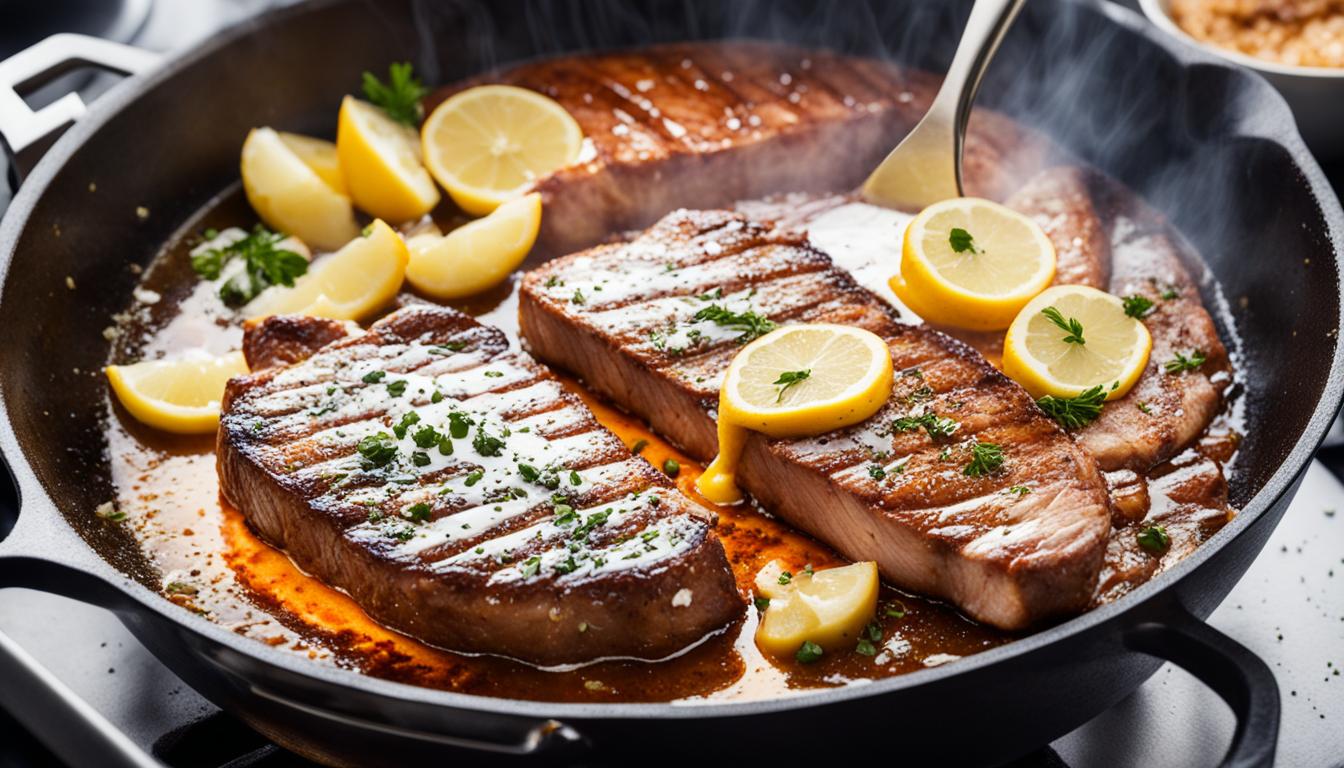Are you tired of the same old boring cooking methods for your steaks, chops, and fish? Want to take your culinary skills to the next level and impress your taste buds? Look no further than the art of butter basting. But what exactly is butter basting and how can it transform your dishes into mouthwatering delights?
The Benefits of Butter Basting
One of the main benefits of butter basting is the incomparable sear it produces. By starting the meat in a hot pan with hot oil and continuing to cook it in butter, you develop a deliciously crisp crust through dehydration and the Maillard reaction.
Butter also adds nutty, rich flavors to the meat or fish, especially when combined with aromatics like garlic and herbs. The best way to baste meats is by using butter, as it enhances the flavor and creates a mouthwatering taste. Whether you’re basting a steak, chop, or fish fillet, the combination of butter and heat creates a symphony of flavors that will elevate your dish to new heights.
Additionally, butter basting is a relatively quick cooking method that delivers excellent results. As you constantly baste the meat with the melted butter, it helps to maintain moisture and even heat distribution. This ensures that the meat remains juicy and tender. However, it’s worth noting that butter basting does require more active time compared to other cooking methods like sous vide or reverse sear. The extra effort is well worth it when you taste the mouthwatering results.
The Science Behind Butter Basting
When you butter baste, you’re not only adding flavor but also creating a chemical reaction that enhances the taste and texture of the meat. The hot pan and oil initially sear the surface of the meat, creating a caramelized crust. This crust provides a delightful crunch and locks in the juices.
As you continue to cook the meat in butter, it goes through the Maillard reaction, a complex chemical process that happens when amino acids and sugars react at high temperatures. This reaction results in the development of rich, savory flavors and enticing aromas. The combination of the caramelized crust and the Maillard reaction creates a mouthwatering flavor profile that will leave you craving more.
Whether you’re a professional chef or a home cook looking to elevate your dishes, butter basting is a technique that will take your cooking to the next level. Its ability to enhance flavors and deliver a perfect sear makes it the best way to baste meats and ensures a memorable dining experience for you and your guests.
When to Use Butter Basting
Butter basting is a versatile cooking technique that can be used with various cuts of meat, including steaks, pork chops, veal chops, and chicken breasts. However, it’s not limited to just meats. If you’re a seafood lover, butter basting is also a fantastic method for enhancing the flavor and texture of fish fillets.
When it comes to seafood, butter basting provides a tender cook and a crispy-skinned bottom, creating a delightful contrast in every bite. The rich flavors of butter complement the delicate taste of fish, making it a winning combination.
While butter basting can be a great option for many dishes, there are a few factors to consider before deciding to use this method. If you’re a beginner or prefer a foolproof cooking technique, you may want to explore alternatives like sous vide or reverse sear. These methods offer more precise control and consistency, ensuring a perfectly cooked dish every time.
Additionally, if you prioritize a consistent internal doneness or need to cook for a larger crowd, sous vide or reverse sear may be better suited for your needs. These methods allow you to cook meat or fish evenly on the inside while still achieving a delicious crust on the outside.
It’s important to note that butter basting works best with smaller cuts of meat and fish. Larger roasts or whole fish may overcook on the exterior before reaching the desired internal doneness. So, for larger cuts, it might be more suitable to choose alternative cooking techniques.
How to Butter Baste Steaks, Chops, & Fish
To achieve the perfect butter basted steaks, chops, or fish, follow these step-by-step instructions. Begin by salting the meat and letting it dry brine for at least 45 minutes. This process helps to enhance the meat’s natural flavors and juiciness.
Next, heat a skillet with oil until it’s nearly smoking, which ensures a proper sear. Place the meat in the hot pan and sear it on both sides until it develops a beautiful caramelized crust.
To add that irresistible buttery goodness, add unsalted butter, garlic, and shallots to the pan. Continuously ladle the melted butter over the meat, making sure to baste every inch. This step helps to infuse the meat with rich and aromatic flavors.
If you’re butter basting fish fillets, cook them skin-side down to crisp up the skin while keeping the flesh tender. Don’t forget to continuously baste the top of the fillets to ensure they stay moist and flavorful.
For even more delicious variations, you can experiment with adding herbs, spices, and other flavors to the melted butter. With practice, you’ll be able to achieve restaurant-quality results and impress your guests with your butter baste recipes.
